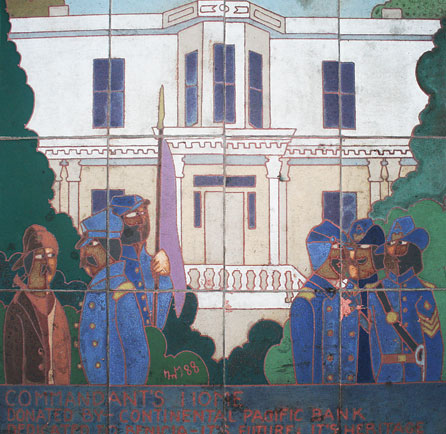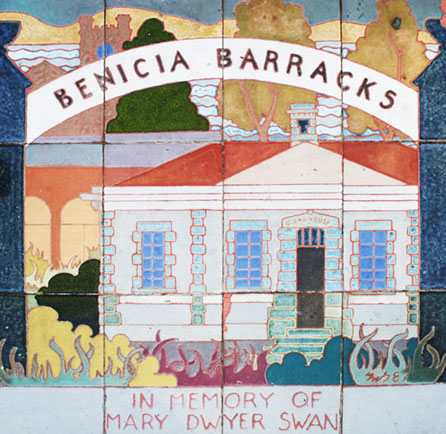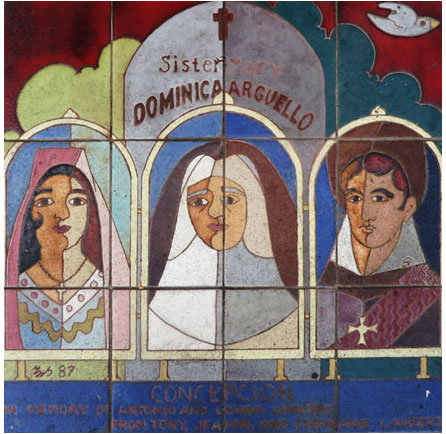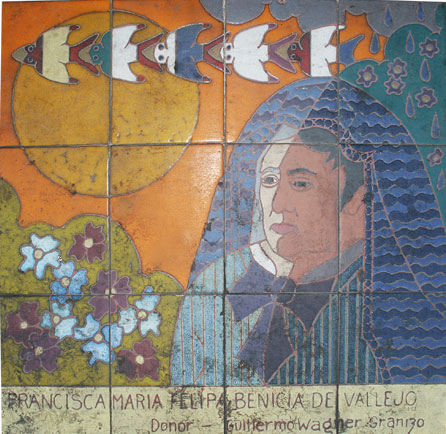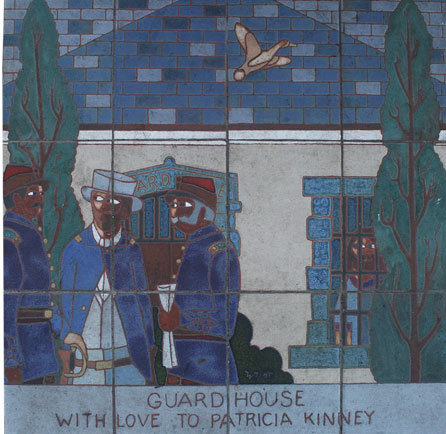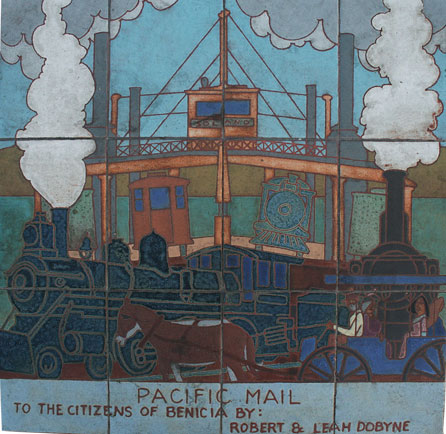
Guillermo Wagner Granizo
First Street Tiles by Guillermo Wagner Granizo
Created by local artist, Guillermo (Bill) Granizo, the sidewalk tiles map the history of Benicia in murals along First Street. Tap on the link on the left to view each tile with a brief description.
Artist Guillermo Wagner Granizo was born in San Francisco in 1923. He spent part of his childhood in Central America and Mexico returning to San Francisco.
The draft summoned him for World War II. He was wounded in his first battle in Europe and returned home to convalesce. After the war he studied at the College of Art in San Francisco. He worked in television, radio and film.
His work is on display in various parts of the United States. Granizo spent his later years in Benicia where he presented these tiles in 1987. He died in 1997.
-
World War I
America’s entrance into World War I in 1917 revived the inactive Benicia Arsenal, the US Army’s main ordnance depot on the West Coast. The Arsenal managed and repaired supplies and armaments that were sent to military forts throughout the Pacific. Its large workforce re-energized Benicia’s slumped economy, even after the war, when it had to deal with the return of unused equipment. Notice the submarine and its periscope in the middle of the tile, possibly a German U-boat?World War II
When World War II started in Europe in 1939 the Benicia Arsenal prepared itself for war, thus enabling it to dispatch convoys of arms to military units shortly after the bombing of Pearl Harbor in 1941. As the main depot for the many battles in the Pacific, it provided munitions and fighting vehicles as well as repair and salvage work. Its most famous recipient was Lt. Col. Jimmy Doolittle, leader of the first bombing raid over Tokyo. Notice the plane under the mushroom cloud. Is it the Enola Gay, the B29 bomber that dropped the atomic bomb?Korean War
The Korean War, 1950-1953, was the last war in which the Benicia Arsenal participated. Before the war the Arsenal was overwhelmed with 146,000 + tons of supplies. By 1951 it had employed over 6500 workers who received and shipped out war supplies including ordinance, jeeps and howitzers by railroad, trucks and barges. After the war four newly constructed warehouses couldn’t hold all of the returned equipment. Workers used tents, tarps and other makeshift shelters to cover the remaining items. Note the stretcher with the IV in the tile, a MASH unit, maybe?Vietnam War
Mid 20th century saw a divided Vietnam torn apart in an aggressive war with the US backing South Vietnam against the North Vietnamese Army. The conflict also divided America. For the first time, television revealed the horrors of war, igniting nation-wide anti-war protests, as depicted on the tile. The war ended in 1975. After more than a hundred years of service the Benicia Arsenal closed on March 30, 1964 with an inactivization order. Too small and too close to a city for modern missile storage. Thanks to Benicia Industries, Inc. who paid $6,000,000, the lease transferred to the city, which developed the Arsenal into an industrial park, helping to revive the economy. -
Clock Tower - 1000 Block West
The Clock Tower is located on the east side of Benicia on a hill overlooking the bay. It was originally a storehouse in the Arsenal. Constructed of sandstone quarried in Benicia, the original three-floor building was finished in 1859. The third floor was considered extraordinary and ambitious in its day as it was suspended from the great timber roof trusses by long iron rods. In 1912 a fire and explosion damaged the inner wooden frame and roof of the building. Only the outer walls of sandstone were salvaged while the roof and floors had to be rebuilt. It now has only two floors and is used for trade shows and other community events.Commandant's Home - 1000 Block West
The home of the commanding officer of the Benicia Arsenal was built in 1860. The first commanding officer to live there was Julian McAllister who presided over the Arsenal 1860-1886. He not only built the Commandant’s Home but also a number of other buildings in the Arsenal and in the city of Benicia. The Commandant’s Home went through extensive remodeling in the 1870s and 1880s changing it from a severe Greek Revival to its present lighter Italianate style. In the late 19th century it was the center of the local social gatherings with people arriving by steamboat from San Francisco. In the early 20th century the Arsenal commander was Colonel James Walker Benet, whose son, Stephen Vincent Benet, received the 1929 Pulitzer Prize for his Civil War poem, John Brown’s Body.Benicia Boy - 1000 Block East
John Carmel Heenan was born in New York but came to California in 1852 at the age of 17 looking for gold. He ended up working in the machine shops of the Pacific Mail Steamship Company in Benicia. The buffed up biceps he gained from the hard work made him a perfect contender for the boxing ring. By the time he returned to the East Coast in 1857, his reputation as a bare knuckle boxer and his good looks earned him the nickname “Benicia Boy”. He won the hand of the then famous stage actress Adah Isaacs Menken although the marriage only lasted a short time. He only fought in three official fights; the most famous was considered the first international boxing championship against Tom Sayres in England which ended up in a draw after more than two hours in the 43rd round. He died of TB in 1873 in Wyoming on route to California where he was hoping to convalesce. He was buried in New York.
-
Masonic Temple - 900 Block West
California’s first Masonic Temple was built in Benicia in 1850 for the cost of $18,000. Alexander Riddle donated the land and Robert Semple donated the lumber. The lower floor was used for county offices when Benicia was the county seat of Solano County. It also accommodated several religious groups. The Masons sold the building in 1888. It was then used by the Kiwanis and the American Legion. The Masons bought it back in 1950. Its design is Greek Revival with two-story pilasters and a Classical pediment.Benicia Barracks - 900 Block Eest
At one time the Benicia Arsenal was two separate posts, the Benicia Barracks and the Benicia Arsenal. The Barracks, one of the first military stations in California, was an infantry post established in 1849 by Lieutenant Colonel Silas Casey occupying 992 acres. The Arsenal was the first Far West ordinance supply post built in 1851 to support the troops. The Benicia Barracks included buildings for the soldiers, officers, a guardhouse and a hospital. All of these buildings were made of frame structures brought from the East Coast except for the hospital which was built from Benicia sandstone. The Benicia Barracks housed the soldiers until 1898 when the Spanish-American War ended. In 1922 all the buildings except the hospital burned down. In 1924 the land and hospital were taken over by the Benicia Arsenal.Cherish Our Past and Embrace Our Future - 900 Block West
Benicia, a town of rolling hills and sea breezes is located on the north side the Carquinez Strait, the waterway connecting the Sacramento Delta to the San Francisco Bay. At one time it was the tribal hunting grounds of the Patwin. It became part of the Mission Solano territory under Spain’s and then Mexico’s rule. The city of Benicia was founded May 19, 1847, and named for the wife of General Mariano Vallejo, who had deeded some of his land for the city. The army established an arsenal that became the largest supply depot on the west coast. The discovery of gold was announced in Benicia in Von Pfister’s adobe store. It became the third state capital, provided a stopping point for the Pony Express and was called the Athens of California for its educational institutions. Benicia is home to a community of artists, fine schools and concerned citizens who care about its past, present and future.St. Paul's - 900 Block East
St. Paul’s Episcopalian Church, with its eye-catching Gothic Revival Architecture started as a small square building in 1859. Col. Julian McAllister, commander of the Benicia Arsenal, drew up the plans for the church. The Right Reverend William Ingraham Kip, First Episcopal Bishop of California consecrated St. Paul’s on Feb. 12, 1860. The changes continued the next 26 years to 1886, including the traditional cross design, redwood panels, stained glass windows and the tall, slender, redwood steeple. One disputed fact is that Norwegian ships’ carpenters who worked for the Pacific Mail Steamship Company sculpted the ceiling to look like an inverted ship’s hull. The rectory behind the church, 122 East J Street, is a salt box house built in 1790 in Connecticut. Col. McAllister had it disassembled, shipped around Cape Horn and reassembled in Benicia in 1868.Concepción - 900 Block East
Maria de la Concepción Arguello, daughter of Don Jose Arguello, Comandante of the Presidio in San Francisco and the first native born Californian to become a nun. Her early life reads like a narrative of romantic novels. In 1806 at the age of fifteen she fell in love with 43-year-old Count Nikolai Rezanov, founder of The Russian-American Company. He had traveled 90 miles from the Russian Fort Ross to negotiate a trade agreement with her father. Promising marriage, the count returned to St. Petersburg to report to the Czar and to get papal dispensation. Sadly, he died en route. Concepción remained true to him, although years passed before she learned of his death. Her piety and charitable works earned her the name, ‘The Blessed One’ or ‘La Beata’. When the Dominicans came to California, she joined the order and helped to establish the convent in Benicia. She became Sister Mary Dominica in 1851. She died December 23, 1857, at the age of 67 and is buried in St. Dominic’s Cemetery in Benicia.Benicia Collegiate Institute - 900 Block East
Charles M. Blake’s boys boarding school opened in 1852 and then forced to close in 1854-55 by the depression. In 1855 Professor C. J. Flatt opened the Benicia Collegiate Institute and by 1858 it had the state’s first law school. Tuition at $35 a month included washing. In 1867 the college was reorganized and incorporated by Dr. James Lloyd Breck and became known as the College of St. Augustine. Espicopalian Bishop J.H.D. Wingfield was one of its trustees. (His residence now privately owned still stands on East O St.) The campus was 60 acres and attended by students from all over the world. It closed in 1889.
-
Captain Walsh’s Home - 800 Block West
Two important considerations regarding this Gothic Revival house are, one, it is considered both historically and architecturally one of the most important houses in Benicia and two, it is the oldest home still occupying its original site within the city. Captain Walsh’s Home is believed to be one of three prefabricated homes that General Vallejo had shipped over from Boston. The first inhabitants in this home were John Frisbee, a banker and landowner and his wife, Epifanía de Guadalupe Vallejo, daughter of General Vallejo. Captain Walsh, a sea captain from Nova Scotia and the deputy collector of Benicia’s port, bought the house in 1849. He was a community favorite who enjoyed entertaining his friends at his beloved home. As for General Vallejo’s other two houses, one was his residence in Sonoma, and the third was located in San Francisco but believed to be demolished before 1900.Dona Francisca - 800 Block West
Benicia’s namesake, Dona Francisca Maria Felipa Benicia Carrillo de Vallejo, was an independent, religious and devoted mother of 16 children. Robert Semple, anxious to form a city on the north shore of the Carquinez Strait, was deeded the land by General Vallejo on the condition that he name it after Vallejo’s wife. Semple honored the agreement naming his new city, Francisca, not only after Vallejo’s wife but also after the Bay of San Francisco. But he was forced to change to her middle name of Benicia when the small village Yerba Buena announced its new name change to San Francisco also named for the bay. Vallejo’s wife happily accepted Benicia and chose to be called by it rather than her first name.Solano - 800 Block West
Ferries played an active role in Benicia almost from its inception. The first ferry was started by one of the founding fathers, Robert Semple, which carried horses across the water. Thanks to the gold rush Benicia’s industry expanded with ocean going vehicles transporting commerce. The Central Pacific Railroad gave Benicia’s industries a further boost. In 1879 it brought in the largest ferryboat in the world, the Solano. At 3,549 tons it could carry two trains and 36 cars on its ten minute ride across the strait to Port Costa. On a busy day it conveyed 30 trains. A second, bigger ferry came along in 1914, the Contra Costa. Benicia’s water activity was impressive with the huge train ferryboats, river steamboats from Sacramento, windships heading for England, schooners with bark from the redwoods, scow schooners from San Francisco and more. In 1930 on the completion of the Benicia-Martinez Bridge the railroad ferryboats were stopped.Young Ladies Seminary - 800 Block East
The first girls’ school in the far west was formed on August 1, 1852, the Young Ladies Seminary on West I Street. Susan Lord was the first principal of this Protestant school. Its board of trustees administered a strict and expensive institution at $200 per 5-month semester which included board, an extra $20 for language and art and another $50 for music lessons. In 1865 Dr. Cyrus Mills and his wife Susan Mills took over and then sold it in 1871, moving on to Oakland to establish Mills College. The last owner Mary Atkins brought in students not only from all over the state but also from different parts of the world. It closed in 1886. California Historical Landmark 795 commemorates the seminary at the City Park.The Corbett-Choynski Fight - 800 Block East
Two San Francisco boxers, known by a range of nicknames including Gentleman Jim and The Panther for Corbett and Battling Joe, the Chrysanthemum for Choynski. Choynski challenged Corbett who accepted under the condition that the match concluded to its illegal finish. (Finished fights were considered brutal and therefore illegal to finish in licensed clubs). Corbett, an amateur, making his professional debut was known for his footwork and Choynski for his powerful punching. The fight started in Marin County in May 1889 but a police raid interrupted it. A lucky break for Corbett as he broke his right thumb during the fight. The fight continued in June in Benicia on a grain barge anchored in Southampton Bay to confuse the authorities. The fight became known as the Barge Fight. Several fishing boats and tugs brought fight fans out to watch. Corbett broke two knuckles on his left hand during the fight and to preserve his hand he created what is now known as the left hook. He won the fight in the 28th bloody round. One newspaper headline read, “Joe Jabbed to Death.” The boxers went on to become lifetime friends and they continued with their boxing career. Corbett became the heavy weight champion in 1892.Guard House - 800 Block East
The Guard House and Engine House were built as one structure in 1872 with the Guard House at the front and the entrance to the Engine House located at the side. The windowless jail cells, situated in the central of the building received very little light and air so, an elaborate ventilation system was installed. The Guard House had solitary cells, a “dark cell”, and a water closet cell. The house was constructed of brick and sandstone but is now covered with stucco.
-
Bella Union- 700 Block West
The Bella Union. A wild west bar during the gold rush? A speakeasy during Prohibition? All that remains now is a boarded up area underneath a present day business on the corner of First and H Streets. Stories passed down from one generation to the next are the only records that exist. A popular hangout during the gold rush, it witnessed pots of gold sliding across the bar and clients with itchy trigger fingers. It closed down in the 1870s. During the era of Prohibition many told stories about people going underground to imbibe illegal beverages. According to one source, during the 1940s and 1950s, a group calling themselves the Old Timers’ Committee discovered the Bella Union while looking for landmarks and opened it up once a year to celebrate Dona Benicia’s birthday. If only its walls could talk.Firefighters - 700 Block West
California’s oldest continuous firefighting volunteer service started in Benicia in 1847 as the Benicia Volunteer Fire Brigade and in 1856 it became the Benicia Volunteer Fire Department. The original Fire House was an annex to City Hall, next door to the Capitol but has since been torn down. The Benicia Fire Museum at 900 East Second St., houses the state’s oldest firefighting engine, the Phoenix, built in the 1820s. Its pumper required 45 men with the necessary skill and dexterity to operate it, so only the best could join the Fire Department. The Phoenix served Benicia for 74 years, 1847-1921. In 1856 each fireman contributed $6.00 to ship a second fire engine around the Horn, the red Hanneman No. 1 engine. The first fire truck arrived in 1915.State Capitol - 700 Block West
California’s induction to statehood in 1850 sparked off a competition among its cities for the capitol. At the first legislative session in San Jose, representatives tried to ‘hawk’ their hometowns. Mariano Vallejo made an offer difficult to refuse of donating land and money in his town of Vallejo. But when the legislators moved there they found the new city unprepared, lacking in amenities. Next stop, Sacramento, but after a flood and fire in the same year, the legislators moved back to Vallejo, only to find the city in the same meager condition. Benicia voted on building a city hall that could be used as the state capitol. The brick structure with the sandstone foundation and Greek Revival trim was completed in 1853. February 1853 the capitol moved to Benicia. Hotels, businesses and a wooden sidewalk sprung up around the new building. Sadly the capital moved back to Sacramento after 13 months. Since then the building has served as county seat, courthouse, school, firehouse, jail and more. It became part of the California State Parks and Recreation after its restoration in 1955-57 and, now, due to cutbacks, the city council has taken over the maintenance.Pacific Mail - 700 Block East
The Pacific Mail Steamship Company, founded in 1848 in New York, acquired the right to carry US mail. On the west coast it transported goods and people along the Pacific down to the Isthmus of Panama. With one of the largest private navies in the world, they chose Benicia for their Pacific dock in 1850 after Benicia founder, Thomas Larkin, successfully lobbied to make Benicia a port of entry. They installed great foundries, machine shops and sleeping quarters where 30 men could stay and double as a fire department. Wharves were built and a 50 ton crane was brought in. Before it closed in 1870 over 2000 were employed to repair and fuel the paddle-wheeled steamships. The brawling, raucous docks at Pacific Mail around East G and East 5th Streets earned the name of Devil’s Street.Congregational Church - 700 Block East
The Congregational Society of Benicia was founded in 1866 and ministered by Justin P. Moore. The First Congregational Church was built in 1868 on West J Street in the style of Gothic Revival. Its minister, Charles Pope, was also the principal of the Young Ladies’ Seminary. The Minister from 1880-1888, Dr. Samuel H. Willey, helped to establish the University of California. In 1893, the church created the first free reading room, precursor of the Benicia Library. In 1896 its minister, Samuel Weyler, founded Benicia High School, holding classes in the newly created Social Hall. On August 28, 1923, a lightning bolt destroyed the main steeple. Luckily, the rain saved the church from an ensuing fire. In 1962 the church sold its building and moved to its new location on West Second Street, transferring the 2300 pound bronze bell cast at the Pacific Mail Steamship Works in 1853, the oak pews that arrived during the gold rush from around the horn and two stained glass windows.Jack London - 700 Block East
Journalist, author and social activist, Jack London, was born in 1876 in San Francisco. He lived and attended school in Oakland and was a student at UC Berkeley. At 16 he bought himself a boat, the Razzle Dazzle, and roamed San Francisco Bay as an oyster pirate. He later changed sides and became a deputy patrolman for the Fish Patrol in 1892. He spent a lot of time in Benicia drinking, brawling, sailing and once nearly killed himself by swimming out in the strait in a drunken state. He wrote stories about his experiences in Benicia in “Tales of the Fish Patrol” and “John Barleycorn”. In his later years between 1903 and 1914 he returned to Benicia to visit friends, fish, drink (one of his famous haunts was Jurgensen’s saloon) and work on his books. He died in his home in Sonoma County in 1916
-
??? - West G Street
Aximis nihilic ipiorae moenirtis publis nequodi cupient. Valabes satusqu iussunterit. Arensum ne consimus fit. Ferferis halis, notil hillestilica Sp. Quod comant? Implibus omnihilius recerorum porteatus vivatrum comnon si serte, quod silie pulicae nos, te, num qua orum unt? Nem nem moribefaudam et octa retifec
-
Accordion content






